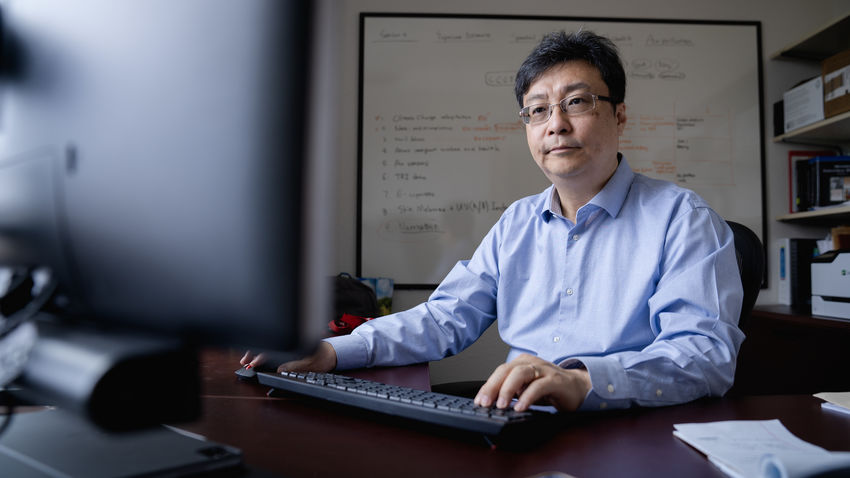
Cars and trucks have a health impact that greener electric vehicles will not eliminate. Tire wear produces plastic dust that gets into air and water. Plastic particles small enough to enter our lungs can contain toxic chemicals and heavy metals, potentially causing heart, lung, developmental, reproductive, and cancer outcomes.
Inkyu Han, an environmental health scientist at the College of Public Health, is about to launch a federally funded study to measure microplastics in the air across Philadelphia neighborhoods. His Characterizing Airborne Microplastics in Philadelphia (CAMP) study is a first step toward identifying the nature and the geography of the issue in the city. Findings could lead to revised public health policies, increased awareness among residents, or guidance aimed at manufacturers.
“Most microplastics research has focused on marine pollution, plastic getting into water and streams,” Han says. "There hasn’t been much research on airborne plastic pollution. My central hypothesis is that the primary source in urban air is tires.”
Production of plastics globally jumped to 584 million tons in 2020, in part from unprecedented demand for single-use plastics during the COVID-19 pandemic. This can get into our bodies. One shocking (but disputed) report in 2019 suggested that humans consume one credit card’s worth of plastic every week. Ingestion of microplastics and smaller nanoplastics (together known as MANs) was once considered the primary route of human exposure, but recent reviews suggest inhalation may be two to three times greater than ingestion via eating and drinking. Researchers in the UK recently wrote that six million tons of tire wear particles are released globally every year, and that tire wear in cities could pose up to four times the risk to the environment of other microplastics.
Han, an associate professor of epidemiology and biostatistics at CPH, came to Temple in 2021 with a zeal to study environmental health. He says it began when, as a student in South Korea, he read the book Our Stolen Future, by Theo Colborn, Dianne Dumanoski, and John Peterson Myers, which explores how endocrine-disrupting man-made chemicals interfere with fertility and fetal development. After earning bachelor’s and master’s degrees in environmental science in Korea, Han trained as an exposure scientist at Rutgers University, earning a PhD in environmental and occupational health. Recently he was appointed as a scientific advisor to the New Jersey Department of Environmental Protection’s public health committee, where he will contribute to policy and program recommendations.
One focus of his research has been occupational chemical exposure among immigrant populations.
“I am an immigrant, and I’m fortunate to be a university faculty member, but many immigrants work in jobs where chemicals can create respiratory, reproductive or other health problems,” he says. Han studied exposure to toxic volatile organic compounds among nail-salon technicians in New York (primarily Asian women) and female domestic workers (primarily Hispanic) in San Antonio, with findings aimed at helping improve those work conditions.
He also has explored chemical exposure and climate effects in disadvantaged neighborhoods. On the faculty at the University of Texas Health Science Center at Houston, he studied metal aerosols in communities near metal recycling facilities. In Houston and in Philadelphia, he has investigated urban areas where residents are exposed to health risks from extreme heat, contributing not just research but community-based action. Through the College of Public Health’s Office of Community Engaged Research and Practice (CERP), Han has taken part in forums in Philadelphia’s Kensington neighborhood, advising residents about staying safe during heat waves.
Now his new CAMP study, funded for two years by the National Institute of Environmental Health Sciences, will examine airborne plastics in Philadelphia. People living in densely populated, high-traffic urban areas are at risk for significant exposure to airborne MANs, Han knows. Many low-income Philadelphians may have no air conditioning, or limited budgets to keep it running, so may spend more time with windows open in warmer months, increasing exposure to outdoor air MANs. The Philadelphia study will pinpoint what’s in the air around the city using intake equipment that captures and filters plastic particles. Advanced spectroscopy techniques will enable the research team to classify plastic particles by type and size and measure the density of their presence in different locations.
“We’ll go to commercial areas, neighborhoods with green spaces, neighborhoods near truck depots or recycling facilities,” Han says. The study could lead to further research that connects the presence of airborne plastics to health outcomes or leads to policy recommendations. “If one community had a high level of microplastics in the air, we could provide that information to regulatory agencies, or to the industry, suggesting that they invest in pollution reduction devices.”
There are no easy answers. Battery-powered vehicles that reduce carbon emissions can be heavier than gasoline models, which may increase tire wear. Manufacturers seeking to meet mileage standards with lighter cars sometimes employ more plastic parts.
But it’s still to be determined whether Philadelphia has a big problem with plastic in the air.
“The levels may not be too high and toxic to human health. Maybe we don’t have to worry about it,” Han says. "We really need to know if there are airborne microplastics in the air we breathe and, if so, the extent of their presence. It's essential for our environmental and public health awareness.”
